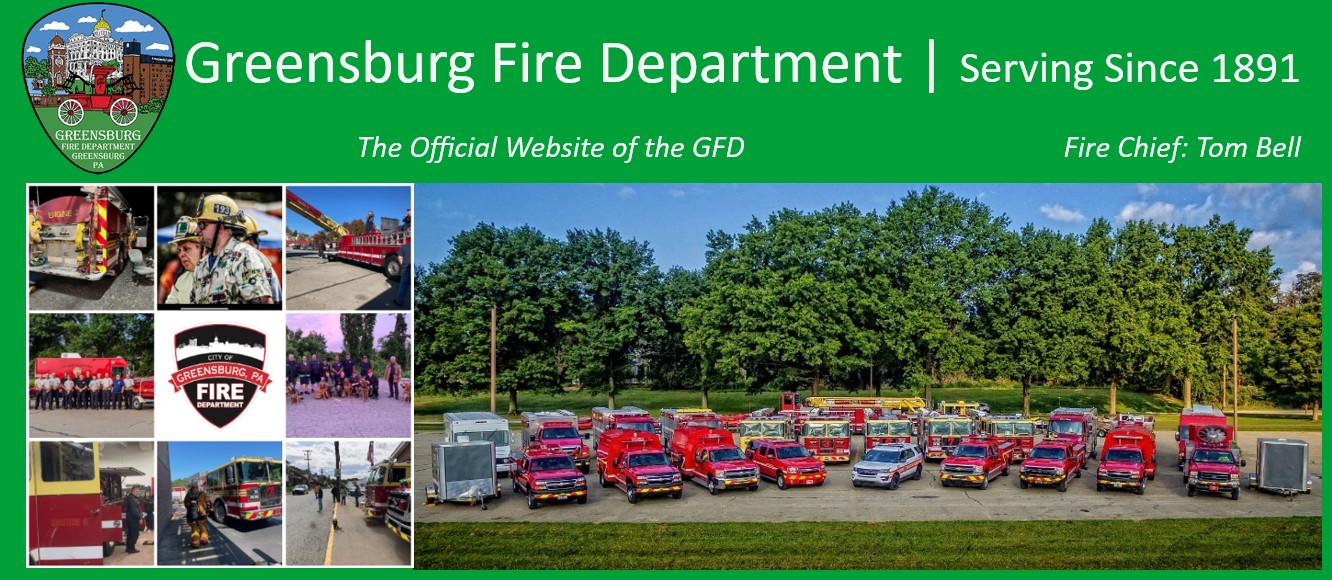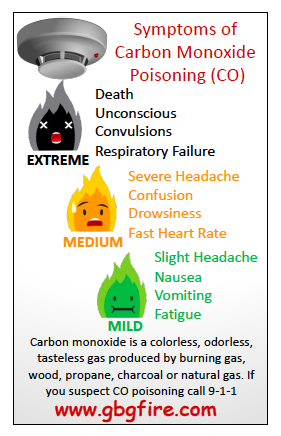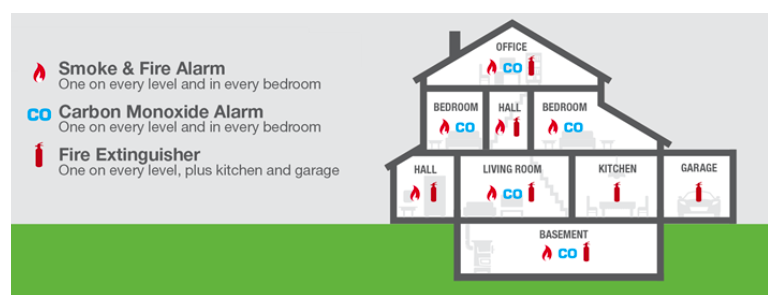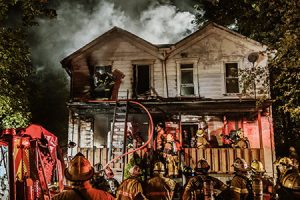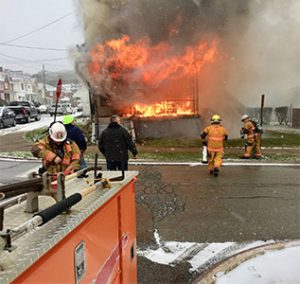Carbon Monoxide (CO) Safety
Carbon monoxide poisoning occurs when carbon monoxide builds up in your bloodstream. When too much carbon monoxide is in the air, your body replaces the oxygen in your red blood cells with carbon monoxide. This can lead to serious tissue damage, or even death. Carbon monoxide is a colorless, odorless, tasteless gas produced by burning gasoline, wood, propane, charcoal or other fuel. Improperly ventilated appliances and engines, particularly in a tightly sealed or enclosed space, may allow carbon monoxide to accumulate to dangerous levels. If you think you or someone you’re with may have carbon monoxide poisoning, get into fresh air and seek emergency medical care.
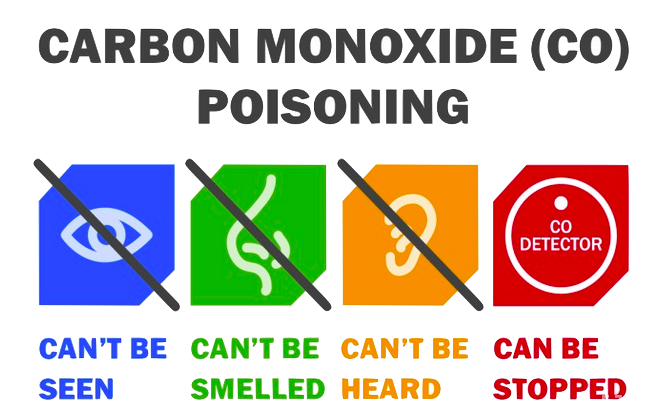
Carbon Monoxide Safety Tips
Carbon Monoxide detectors do not serve as smoke detectors and vice versa. However, dual smoke/CO detectors are also sold. Smoke detectors detect the smoke generated by flaming or smoldering fires, whereas CO detectors can alarm people about faulty fuel burning devices to prevent carbon monoxide poisoning.
What is carbon monoxide?
Carbon monoxide, known by the chemical formula “CO”, is a poisonous gas that kills approximately 534 people in the United
States alone every year. Of that number, about 207 people were killed by carbon monoxide emitted from a consumer product,
like a stove or water heater. You can’t hear, taste, see or smell it. It’s nicknamed the “silent killer’ because it sneaks up on its
victims and can take lives without warning.
What are the sources of CO?
CO is a by-product of incomplete combustion. CO sources can include malfunctioning appliances — including furnaces,
stoves, ovens and water heaters — that operate by burning fossil fuels such as natural gas or liquefied petroleum (LP). When
malfunctioning appliances aren’t adequately ventilated, the amount of CO in the air may rise to a level that can cause illness
or even death. Other CO sources include vehicle exhaust, blocked chimney flues, fuel-burning cooking appliances used for heating purposes, and charcoal grills used in the home, tent, camper, garage or other unventilated areas.
What Are The Effects of Various Levels of Carbon Monoxide?
Digital display models show levels of CO, displayed in ppm (parts per million). Anytime the alarm sounds, whether it is an alarm with a digital display or not, it should be treated as a potentially serious situation.
The concentration of CO is a determining factor in the symptoms for an average, healthy adult.*
- 50 ppm: No adverse effects with 8 hours of exposure.
- 200 ppm: Mild headache after 2-3 hours of exposure.
- 400 ppm: Headache and nausea after 1-2 hours of exposure.
- 800 ppm: Headache, nausea, and dizziness after 45 minutes; collapse and unconsciousness after 1 hour of exposure.
- 1,000 ppm: Loss of consciousness after 1 hour of exposure.
- 1,600 ppm: Headache, nausea, and dizziness after 20 minutes of exposure.
- 3,200 ppm: Headache, nausea, and dizziness after 5-10 minutes; collapse and unconsciousness after 30 minutes of exposure.
- 6,400 ppm: Headache and dizziness after 1-2 minutes; unconsciousness and danger of death after 10-15 minutes of exposure.
- 12,800 ppm: Immediate physiological effects, unconsciousness and danger of death after 1-3 minutes of exposure.
Anytime someone is experiencing the symptoms of CO poisoning, it should be treated as an emergency.
- Move them and the family outdoors and call emergency services.
- Do not reenter the premises until emergency services responders have given you permission to do so.
If the alarm reactivates within a 24-hour period, repeat the above steps and call a qualified appliance technician to investigate sources of CO from fuel-burning equipment and appliances, and to inspect for proper operation of equipment.
How many carbon monoxide alarms do I need in my house?
Proper placement of a carbon monoxide (CO) detector is important. If you are installing only one carbon monoxide detector, the Consumer Product Safety Commission (CPSC) recommends it be located near the sleeping area, where it can wake you if you are asleep. Additional detectors on every level and in every bedroom of a home provide extra protection against carbon monoxide poisoning. Homeowners should remember not to install carbon monoxide detectors directly above or beside fuel-burning appliances, as appliances may emit a small amount of carbon monoxide upon start-up. A detector should not be placed within fifteen feet of heating or cooking appliances or in or near very humid areas such as bathrooms. When considering where to place a carbon monoxide detector, keep in mind that although carbon monoxide is roughly the same weight as air, it may be contained in warm air coming from combustion appliances such as home heating equipment. If this is the case, carbon monoxide will rise with the warmer air. Installation locations vary by manufacturer. Manufacturers’ recommendations differ to a certain degree based on research conducted with each one’s specific detector. Therefore, make sure to read the provided installation manual for each detector before installing.
What should you do when the CO alarm sounds?
Never ignore an alarming CO alarm! It is warning you of a potentially deadly hazard.
If the alarm signal sounds do not try to find the source of the CO:
- Immediately move outside to fresh air.
- Call your emergency services, fire department, or 911.
- After calling 911, do a head count to check that all persons are accounted for. DO NOT reenter the premises until the emergency services responders have given you permission. You could lose consciousness and die if you go in the home.
- If the source of the CO is determined to be a malfunctioning appliance, DO NOT operate that appliance until it has been properly serviced by trained personnel.
If authorities allow you to return to your home, and your alarm reactivates within a 24 hour period, repeat steps 1, 2 and 3 and call a qualified appliance technician to investigate for sources of CO from all fuel burning equipment and appliances, and inspect for proper operation of this equipment. If problems are identified during this inspection, have the equipment serviced immediately. Note any combustion equipment not inspected by the technician and consult the manufacturers’ instructions, or contact the manufacturers directly, for more information about CO safety and this equipment. Make sure that motor vehicles are not, and have not been, operating in an attached garage or adjacent to the residence.
